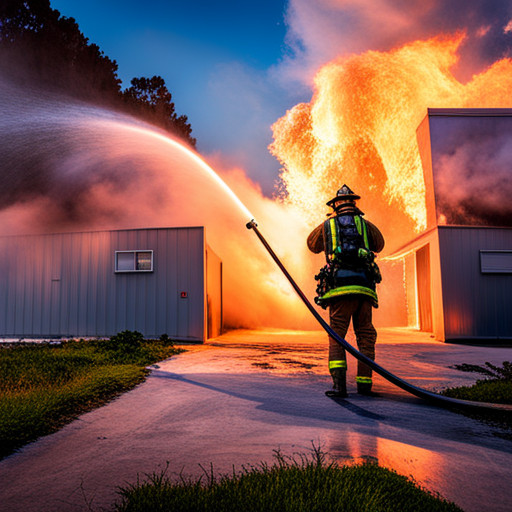Shaping Safety Standards After Camp Lejeune
The article examines the significant influence of the Camp Lejeune incident on contemporary safety standards.

By delving into its historical context, dissecting experienced safety issues, and evaluating responses to the event, it provides a comprehensive analysis.
The article further explores how this incident has shaped current protocols and discusses potential implications for future safety regulations.
Key Takeaways
- The contamination of water sources at Camp Lejeune due to the presence of volatile organic compounds (VOCs) led to various health consequences, including birth defects and childhood cancers.
- In response to the incident, remediation efforts were implemented, including comprehensive clean-up of contaminated sites and improved water treatment facilities. A registry was also created for affected individuals, and healthcare provisions were established.
- The Camp Lejeune incident resulted in a transformation of safety standards across military bases, known as the Lejeune Lessons. This included strict compliance with health protocols, continuous improvements to guidelines, and the introduction of stricter quality control checks and advanced detection methods.
- The implications for future safety regulations include increased emphasis on personnel training and awareness programs, enhanced monitoring mechanisms, and the recognition of the importance of effective implementation and regular review of safety protocols. The incident also highlights the need for continued focus on preventing and addressing contamination issues in military environments.
The Historical Background of Camp Lejeune

Established in 1941, Camp Lejeune has a significant historical background that played an instrumental role in shaping the safety standards of military bases. Situated on approximately 246 square miles of land in North Carolina, this base was primarily designed for amphibious assault training during World War II.
The strategic importance of Camp Lejeune during several notable military operations underscores its significance within the broader context of U.S. military evolution. The camp served as a crucial hub for the development and implementation of innovative combat strategies, thereby contributing to Lejeune's legacy.
Moreover, it is worth noting that a critical aspect of this legacy involved a constant reassessment and enhancement of safety standards at the base. This process was propelled by both internal assessments and external pressures such as governmental regulations or public scrutiny following incidents at other bases.
In retrospect, Camp Lejeune not only emerged as a vital cog in America's defence machinery but also became an exemplar for other military bases regarding safety protocols. It introduced measures like regular personnel drills, infrastructure checks, and stringent rules about handling weapons and explosives.
However, while these developments were commendable, they were not impervious to challenges. Instances such as environmental contamination due to industrial activities have marred Lejeune's legacy. Yet these setbacks only spurred further improvements in safety measures at military bases across the country.
The Safety Issues Experienced at Camp Lejeune

Historical analysis reveals numerous health and well-being concerns that arose from the living conditions at this military base. A significant issue was the contamination of water sources, which led to a variety of adverse health consequences for those stationed at Camp Lejeune.
Investigations highlighted that volatile organic compounds (VOCs), specifically trichloroethylene (TCE), tetrachloroethylene (PCE), vinyl chloride, and benzene were present in the drinking water. These hazardous substances originated from solvents disposed off improperly on base property. The contamination effects were widespread due to the use of this polluted water for several decades from 1953 until regulated disposal procedures were implemented in 1987.
These VOCs are known carcinogens and have been linked with numerous health consequences. For instance, TCE exposure is associated with kidney cancer, non-Hodgkin lymphoma, and liver disease while PCE has been implicated in bladder cancer, multiple myeloma, and non-Hodgkin lymphoma among others.
Furthermore, benzene has been connected to childhood leukemia as well as acute myeloid leukemia in adults. Vinyl chloride also poses serious health risks including angiosarcoma of the liver and lung cancer.
The extent of these contamination effects prompted an epidemiological study by the Agency for Toxic Substances Disease Registry (ATSDR). Results revealed a higher prevalence of birth defects and childhood cancers among offspring born to mothers who resided at Camp Lejeune during their pregnancies compared to other military bases. This finding further underscored the dire need for stringent safety measures at such installations moving forward.
The Response to the Camp Lejeune Incident

In response to these alarming revelations, immediate and stringent measures were taken by the concerned authorities to address the contamination issue. The first step in this process was acknowledging the Response Failures that had led to a situation of such magnitude. It became clear that there had been significant lapses in monitoring and regulating safety standards at Camp Lejeune.
The authorities then moved on to implementing Remediation Efforts designed to rectify the issues presented by the contamination. These efforts involved a comprehensive clean-up of contaminated sites, which was executed with rigorous precision. In addition, improved water treatment facilities were installed as part of an effort to prevent future occurrences of such incidents.
Despite these steps, it was evident that more needed to be done in order to fully address the situation. An element of transparency was added into proceedings when a registry for affected individuals was created and made publicly accessible. Additionally, healthcare provisions were established for those who had suffered as a result of exposure.
However, despite these actions, criticism has been levelled at what some view as inadequate responses given the scale and severity of the issue faced at Camp Lejeune. This highlights an ongoing need for further investigation into this incident and how it was handled.
How Camp Lejeune Impacted Current Safety Standards

The repercussions of the incident resulted in a significant overhaul of current precautionary measures across various military bases. This transformation, often referred to as the Lejeune Lessons, reflects how the event at Camp Lejeune prompted significant progress in safety standards enforcement within military environments. These lessons signify an essential turning point that led to an evolution in standard practices.
In-depth analysis and investigation following the incident revealed discrepancies in adherence to safety regulations. Consequently, efforts were intensified to ensure strict compliance with health protocols across all levels of operation within military bases. The primary focus was on water quality management procedures, given that contamination was identified as a critical factor leading to numerous health issues among Camp Lejeune residents.
This scenario triggered what is now recognized as Standard Evolution – a process marked by continuous improvements and updates to existing guidelines based on lessons learned from past incidents. The objective is not just about putting robust systems into place but also ensuring their effective implementation and regular review for potential areas of improvement. In this context, monitoring mechanisms were significantly enhanced while contingency plans underwent rigorous revisions.
The introduction of stricter quality control checks, comprehensive risk assessments, and advanced detection methods are some notable outcomes of this evolutionary process initiated by the Lejeune Lessons. Furthermore, there has been an increased emphasis on personnel training and awareness programs regarding safety protocols.
This shift towards more stringent standards underscores a significant breakthrough born out of unfortunate circumstances - highlighting that even tragic events can lead to progressive changes when lessons are learned and implemented effectively.
Future Implications for Safety Standards After Camp Lejeune

Future implications for precautionary measures, following the incident at the military base, point towards a more preventive and proactive approach rather than reactive. This shift is evident in legislation changes and implementation of stringent preventive measures that prioritize safety above all else.
The incidents at Camp Lejeune have led to an overhaul of safety regulations within military bases, necessitating the revision of existing policies and development of new ones that focus on prevention. The resulting legislative changes are indicative of this preventative approach, including stipulations for regular site inspections, mandatory reporting of any potential environmental hazards, and comprehensive health screenings for personnel.
Such legislative changes also stress the importance of robust monitoring systems capable of early detection and swift action to mitigate any potential threats. Preventive measures now include routine risk assessments designed to identify possible sources of contamination or other risks before they materialize into actual problems.
Furthermore, these preventive measures extend beyond immediate physical safeguards to include education and training programs aimed at fostering a culture where safety considerations are integral to everyday operations. Personnel are equipped with knowledge on identifying risks and appropriate response protocols thereby enhancing overall preparedness.
Frequently Asked Questions
What Was the Daily Life Like for Soldiers Stationed at Camp Lejeune During Its Operational Years?
Daily life for soldiers stationed at Camp Lejeune involved rigorous training exercises, fostering physical and tactical readiness. Recreational activities provided respite, contributing to a balanced lifestyle within the demanding military environment.
Are There Any Notable People Who Were Stationed at Camp Lejeune?
Multiple notable individuals, distinguished by Lejeune Leadership Styles, have been stationed at Camp Lejeune. These include famous Lejeune Veterans such as General James L. Jones and Major General Raymond L. Murray among others.
How Has the Local Community Around Camp Lejeune Been Affected by the Safety Issues?
The local community around Camp Lejeune has experienced significant health impacts and economic consequences due to safety issues, including increased medical costs and diminished property values resulting from environmental contamination.
What Were Other Military Bases Doing in Terms of Safety Standards at the Time of the Camp Lejeune Incident?
At the time of the Camp Lejeune incident, other military bases were variably implementing safety standards, with some adhering to newly enacted Lejeune Legislation and others grappling with contamination consequences of lax regulations.
Are There Any Upcoming Developments or Changes Planned for the Site of Camp Lejeune?
Future developments for the site of Camp Lejeune include rehabilitation efforts aimed at environmental restoration, though comprehensive details remain undisclosed. Changes are anticipated to prioritize safety standards and sustainable practices moving forward.
Conclusion
In conclusion, the historical significance of Camp Lejeune cannot be understated.
The incident not only exposed glaring safety issues but also prompted a swift response that led to significant changes in safety standards.
The lessons learned from this impactful event continue to shape future implications for safety regulations and protocols, thereby ensuring safer living conditions for military personnel and their families.

This post has been generated by AI and was not reviewed by editors. This is Not legal advice. Please consult with an attorney.




